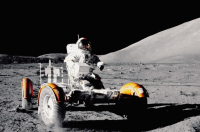It’s been a big year for science at ITMO, so much so that it can be tough to pick the very best! To review all of the past year’s developments, visit the Science section of our website – or better yet, check out all the previous installments of our Science Roundup series.
***
Physics and more
A new method of twisting particles with the help of a laser beam means it’s now possible to conduct experiments with twisted photons in particle accelerators. Quite timely, too: after all, ITMO University has recently joined the interuniversity consortium of the Siberian Ring Photon Source, a megascience project under construction near Novosibirsk.
Speaking of lasers, our scientists broke their own record and once again created the world’s smallest nanolaser – with a beam just 200 nm in size! In other news, a team at the Faculty of Physics had resolved the mystery of ultrafine plasmonic particles or, more specifically, their spectral properties.
Next, a story straight out of sci-fi: a system that “binds and controls particles of light and matter.” It may sound like fiction, but this is quite an accurate description of the new technology that provides a middle ground between electronic and optical computing. Similarly, another new invention, courtesy of the International Research and Educational Center for Physics of Nanostructures, is a universal microscope plug-in that can hold individual nanoparticles in place for easy analysis.
Read also:
Medicine
In the field of medicine, quite a few major developments were made in the fight against cancer. The staff of ITMO’s ChemBio Cluster, for instance, were able to train DNA constructs to target cancer cells; a team of physicists had devised a multifunctional material for melanoma therapy; and their computer scientist colleagues discovered a connection between the human gut microbiome and the effectiveness of melanoma treatment.
And while it may be some time before we see the first artificial brain, a study by ITMO researchers has already described hybrid crystals that behave like brain neurons, which may potentially serve as the basis for the next generation of computing devices.
Read also:
- ITMO Scientists Produce Novel AI-Powered Platform To Fight Antibiotic Resistance
- New by ITMO Scientists: Digital Service to Facilitate Artificial Enzymes for Industry and Medicine
- ITMO’s New Compound Disables Disease-Producing Genes 17 Times Faster Than Counterparts
- Supersensitive Express COVID-19 Test Developed at ITMO
Artificial intelligence
Of course, there were bound to be some major achievements in AI, too. For instance, the bright minds of ITMO’s ChemBio Cluster used machine learning to develop a nanoparticle-screening platform for medical and agricultural use. Designed to assist in the fight against antibiotic resistance, it can identify metal oxides that would serve as viable replacements for these medical products.
Another highly practical invention, devised by a startup hailing from ITMO, is an AI-powered headset for on-site workers in the oil and gas industry. The wearable gadget connects its user with remote experts, allowing them to work in tandem even on the most complex tasks. The transparent, sci-fi-esque visor even uses augmented reality tech to highlight objects, display relevant info, and more.
Read also:
See more highlights of the year at ITMO in our month-by-month overview.




